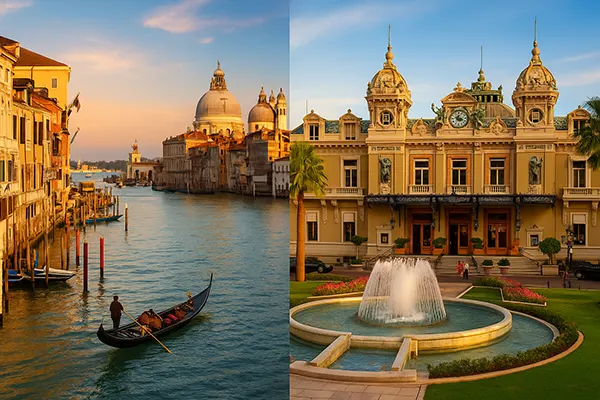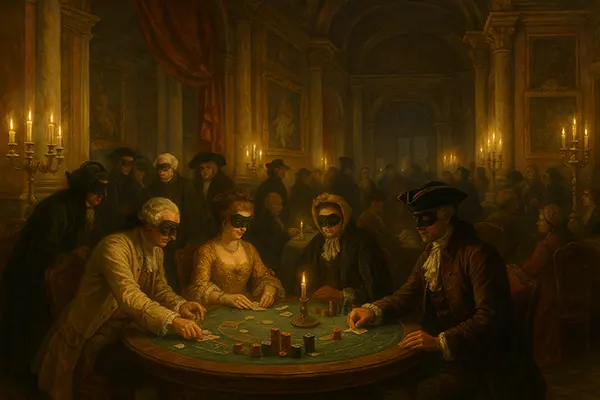
The Golden Age of Casinos in Venice and Monte Carlo
The history of gambling houses in Europe is closely tied to two legendary cities: Venice and Monte Carlo. Both locations shaped the image of luxury, sophistication, and high-stakes play. From the creation of the Ridotto in the 17th century to the grand salons of Monaco in the 19th century, these destinations forged traditions that still define gambling culture today.
The First Official Casino in Venice: Ridotto, 1638
In 1638, the Venetian government authorised the Ridotto, often considered the first official casino in the world. Established inside Palazzo Dandolo near San Moisè, it was designed as a controlled environment where noble citizens could gather and play games of chance. This decision came at a time when Venice was struggling with unregulated gambling that had spread across the city’s taverns and private clubs.
The Ridotto was strictly regulated. Entry was limited to the elite, and players were required to wear masks, in line with the traditions of Venetian carnival. Games such as biribi and bassetta were popular among guests, while the opulent surroundings reflected the grandeur of Venice at its economic and cultural peak. For the Republic, this establishment served not only as entertainment but also as a means to generate income and maintain order.
Although the Ridotto closed in 1774 after criticism that it encouraged decadence, its influence remained. It inspired the creation of similar establishments across Europe and gave birth to the concept of the modern casino — a regulated space where gaming and social interaction were combined.
Venice as the Pioneer of Casino Culture
The Ridotto laid the foundation for how casinos would operate in centuries to come. By combining exclusivity, regulation, and spectacle, Venice positioned itself as the birthplace of European gambling culture. Its controlled environment served as a model for future establishments, showing how authorities could balance revenue generation with societal order.
Furthermore, Venice established the association between casinos and cultural sophistication. Gambling was not merely about chance but about belonging to an elite circle of society. This connection between play, culture, and prestige would echo across Europe and beyond.
Even today, Venice’s historical contribution to gambling is remembered with pride. Modern visitors to the city often see it not only as a cultural capital of art and architecture but also as the cradle of casino tradition.
Monte Carlo: Luxury and Gambling in the 19th Century
By the 19th century, Monte Carlo had risen as the new capital of European high society. In 1863, Prince Charles III of Monaco supported the creation of the Monte Carlo Casino to revitalise the struggling principality. Its establishment quickly transformed Monaco into a magnet for aristocrats, financiers, and royalty from across Europe.
The casino’s success was tied to its combination of elegance and innovation. Designed by architect Charles Garnier, who also built the Paris Opera, it offered a glamorous environment filled with chandeliers, frescoes, and marble halls. Unlike the Venetian Ridotto, the Monte Carlo Casino was a symbol of prosperity for an entire state, funding Monaco’s economy and elevating its international reputation.
Monte Carlo became synonymous with sophistication and wealth. Its reputation was further strengthened by literature, cinema, and the arrival of luxury hotels and theatres. The city was no longer just a destination for gaming but a showcase of refined European lifestyle.
Monte Carlo as a Symbol of Elegance
Monte Carlo represented more than gambling; it embodied a vision of modern luxury. Aristocrats and wealthy travellers flocked there not just to play, but to see and be seen in Europe’s most fashionable setting. The combination of sea views, architecture, and social glamour ensured its legendary status.
Writers such as Fyodor Dostoevsky immortalised Monte Carlo in works like “The Gambler,” highlighting both its allure and the risks of obsession. Later, films and popular culture cemented its place as an icon of glamour. James Bond stories, for example, often depicted the city as the epitome of high-stakes elegance.
Monte Carlo’s enduring prestige lies in this blend of myth and reality. Its casino is not just an entertainment venue but a cultural institution that shaped global perceptions of gambling.

Why Venice and Monte Carlo Remain Legendary
Both Venice and Monte Carlo hold a unique place in the history of gambling. Venice pioneered the concept of a regulated gambling house, while Monte Carlo elevated it to a spectacle of wealth and elegance. Together, they created a legacy that continues to inspire casinos worldwide.
These cities are not simply remembered for their buildings but for the atmosphere they created. They associated gambling with social identity, cultural sophistication, and international allure. As a result, both became symbols that transcend their geographic boundaries, influencing how the world perceives casino culture even today.
In the 21st century, despite the rise of modern gaming hubs in Las Vegas, Macau, and Singapore, Venice and Monte Carlo remain unmatched in their historical significance. They stand as reminders of how tradition, culture, and luxury shaped the golden age of casinos.
The Enduring Legacy of Legendary Cities
The continued fascination with Venice and Monte Carlo highlights their influence on global gambling culture. They remind us that casinos were never merely places for play but institutions tied to culture, politics, and society.
Visitors still regard these cities as destinations where history and glamour intertwine. Venice preserves its aura through cultural tourism, while Monte Carlo continues to welcome global elites to its halls. Each has retained its distinctive identity while remaining part of a shared legacy.
The golden age of casinos is not simply a chapter in history but a living tradition that continues to shape perceptions of gaming. Venice and Monte Carlo remain eternal symbols of elegance, risk, and cultural prestige.
